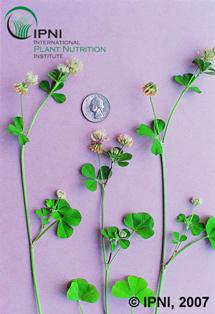Ball Clover
Adaptation
- Coastal Plain and lower Piedmont.
- Best on loam to clay soils.
- Tolerates poor drainage.
- Excellent reseeder.
- Excellent honey producer.
Establishment
Seed in October-early November, usually planted with cool season annual grasses. Because this species is often seeded with multiple grass and/or legume species, see Establishment of Cool Season Annual Legumes for more details. Also, because this species is small seeded, see Seeding Methods for Small Seeded Legumes for details on how to successfully plant.
Recommended Varieties
Grazer, Select, and Don
In-Depth
 Ball clover has long, highly-branched stems that support white to yellowish-white flowered seed heads that look similar to white clover seed heads. Ball produces most of its growth about one month later in spring than crimson and generally does not produce as much total forage as crimson. However, its advantage over crimson is that it is an excellent reseeder, even under close grazing. When grazed heavily, ball clover produces seed heads close to the ground. It is more tolerant of wet soils than crimson, but it does not do well if soil pH drops below 6.0.
Ball clover has long, highly-branched stems that support white to yellowish-white flowered seed heads that look similar to white clover seed heads. Ball produces most of its growth about one month later in spring than crimson and generally does not produce as much total forage as crimson. However, its advantage over crimson is that it is an excellent reseeder, even under close grazing. When grazed heavily, ball clover produces seed heads close to the ground. It is more tolerant of wet soils than crimson, but it does not do well if soil pH drops below 6.0.
Dr. Dennis Hancock
Forage Extension Specialist
Crop & Soil Sciences Dept.
